Is it true what they say? That I will never have to clean my gutters. Micro mesh gutter guards, like Leaffilter or any on the many types. Find out the truth about gutter guards. Over the years we have tested almost every gutter guard on the market. See the conclusion Continue reading “Micro Mesh Gutter guard Leaffilter – The truth about gutter guards!”
Copper Gutters: Cost and How to Choose
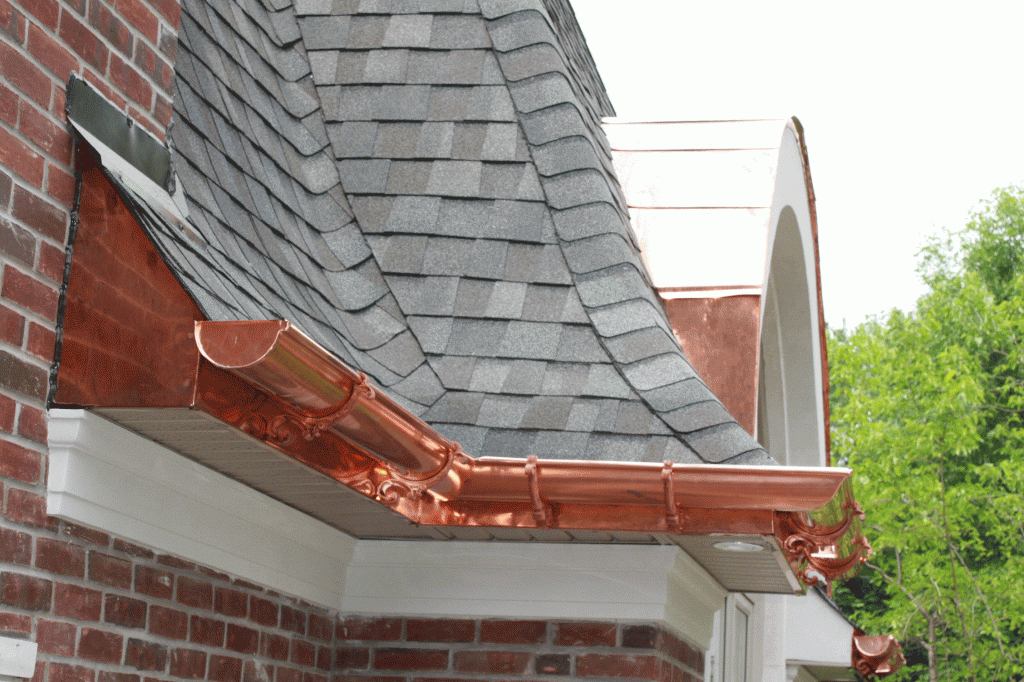 Copper Gutter — it’s the most elegant and prestigious choice for a rain gutter system available. Hands down.
Copper Gutter — it’s the most elegant and prestigious choice for a rain gutter system available. Hands down.
You’re likely here because you’re considering copper gutter for your own home. You may have heard it’s the most expensive option on the market (you’re right). You may also sense that copper gutter would add a truly dramatic look to your home — and possibly even be a good long-term investment.
Copper may be for you, or it may not. I want to help you find out.
Customers walk into our building supply warehouse often and ask themselves this same question. Let’s imagine you walked into our warehouse too. It’s time to talk pros and cons. Here’s the exact checklist we’d walk through together:

Would copper gutter suit your dream home?
Your home is one of your most valuable assets. It’s your masterpiece, a reflection of your personal taste, it’s your own piece of heaven.
Cost simply has to be one of the last considerations in the equation (ahem.. see the next question below). The conversation has to begin with the sincere, deep-rooted feelings you have for your home. Do you truly want the very best for your home?
To you and your family, your home may be your own, personal Fallingwater. In such cases I almost always recommend using the best materials you can that suit your theme. Your gutter selection is an important material among these, as it’s highly visible from all sides of the house. So, if copper truly enhances the natural, distinct, thoughtful details of your dream home, then copper might be a winner.
Are you willing to pay for copper vs aluminum?
Okay, let’s get into the meat and potatoes. What does copper gutter cost relative to aluminum?
Let’s use 2 different homes to use as examples. First, we have House A — a popular 2-story, 2,000 sq ft home. A home this size will require about 200 linear feet of rain gutter — that’s about the national average. Second, we have House B — a 3-story, 6,000 sq ft estate. For kicks, let’s pretend it’s an Italian-style villa overlooking the Pacific Ocean. House B will require about 400 linear feet of gutter.
Quick disclaimer here — keep in mind that a majority of gutter installation cost depends on your general contractor’s rate, ability and zip code. You’re always wise to check with several different contractors for quotes on gutter to find the best value possible.
A standard, aluminum gutter system will run a homeowner approximately $3.50 to $7.00 per linear foot (again, range dependent on contractor rate). For House A, the total cost after material and labor would range between $700 and $1,400 in total. For House B, the total cost would fall between $1,400 and $2,275.
Now, let’s switch to a custom, copper system and run the same numbers. Copper will run $18.50 and $26.00 per linear foot. Installation for House A will cost about $3,700 – $5,200. For House B, about $7,400 – $10,400.
There you have it: the cost to fully install the most desirable gutter system the world can offer. Here’s how it compares visually; this chart is the average of the costs outlined above. Yes, copper will cost 3x, 4x, and in some cases even 5x more than aluminum gutter. That’s why I defer to that first question — are you able and willing to make your dream home the best it can be?
Average cost comparison for a 200 linear ft system

Do you understand why copper is more expensive?
Important to know all the facts. Let’s deconstruct what you’re paying for here:
- Copper is a much more expensive alloy than aluminum — you probably knew that.
- You also need copper everything, including accessories and fasteners. Aluminum hangers will react adversely and actually break down the copper. A definite no-no. Always hang copper with either copper itself, brass or stainless steel.
- Copper requires extra time and care for your contractor to install and prevent pre-mature tarnishing. Copper even requires special gloves for installation.
- Copper often requires additional soldering around the joints. Extra work = more labor = higher cost.
Are copper gutters a good long-term investment for you?
Like other investments in life, your decision to purchase a copper gutter system will depend on a variety of factors, your end goal, and ultimately, what makes you happy. Some more questions to consider:
- Is the home or building in an exclusive, high-end neighborhood? Will copper help your home stay consistent with your neighbors’ homes?
- Do you want your home to truly pop out among other homes in your neighborhood? How will the extra curb appeal help increase the value of your home?
- What is your time horizon? If you plan to live in your home for 30+ years, your copper gutter should hold strong and hopefully satisfy your aesthetic tastes for decades. Likewise, if you plan to sell in the short-term, a copper gutter system could be one of the extra fine details that has your prospects swooning.
- Are you replacing pre-existing copper spouting? If it was good enough to impress you to purchase, it will likely achieve the same effect when you go to sell. Is it worth the risk to “cut corners”? That’s for you to decide.
- How important a factor is durability to you? If you want the most durable and lost-lasting material for gutters, copper is it. It’s a more solid alloy than aluminum, it never rusts and it never needs painting.
Do you love the look of copper?
Ultimately, this perhaps the most important question. We’re passionate about gutters here, but it’s not too often we hear customers say that gutter warms their soul like, say, the look of a terra-cotta roof.
Not to be dramatic, but seeing copper gutter should warm your soul. That’s the clincher. You need to love it.
Brick, stone, stucco, wood, slate — all these materials tend to look GREAT with copper gutter. Also, do you truly like the look of tarnished copper? If you live in the Pacific Northwest USA, you will likely see your copper gutter turn green within a year or two. If you live in sunny San Diego, then your copper gutter will likely keep its original color for years.
It depends on the climate where you live. It’s important to know if you would truly love your home with copper-colored OR time-weathered green gutter. Both looks can work, but again, it’s your personal preference.
How do Rain Chains work?
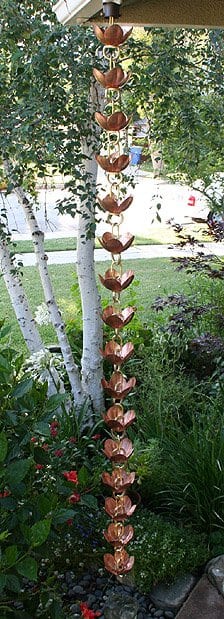 Rain chains are a unique addition to a home’s rain gutter system. They function well and also add a pleasant waterfall sound as the rainwater travels downward from cup to cup or link to link. A pleasant ‘white noise’ sound is heard when just a chain is used without the cups. Most homeowners will place them near a window or landscaped area for a visual experience when it rains.
Rain chains are a unique addition to a home’s rain gutter system. They function well and also add a pleasant waterfall sound as the rainwater travels downward from cup to cup or link to link. A pleasant ‘white noise’ sound is heard when just a chain is used without the cups. Most homeowners will place them near a window or landscaped area for a visual experience when it rains.
Normally a downspout will drain rainwater from the roofs gutters onto the concrete or lawn and the same can be done with a rain chain. The difference is the rain chain doesn’t have a tube and corners to flow through. It will not clog the gutters or drain system with leaves and debris.
Over many years I have received calls from customers that have asked how they can stop that nagging dripping and echo sound from a downspout near their bedroom. I have heard more than one person say, “Hearing that drip all night is driving me crazy.”Replacing the downspout with a rain chain is a custom way to fix this problem with the benefit of a peaceful relaxing sound.
Some of the first records of a rain chains being used are from Japan. They were used to collect and save fresh rainwater. This captured water was stored in barrels for future use and some people today find this conservation of rainwater to be useful. We have a full line of rain chains available and have been in business since 1983. We offer a variety of different cups and chains that will surprise you.
Rain Chains are made with primarily copper or brass. I have used raw steel chains many times that turns a rusty brown color with age. When using copper chains, after a few years they turn a beautiful color or what is called patina. Brass turns a dark golden brown.
It is my advice when installing a rain chain that they should be connected directly to a hole in the gutter. When replacing a downspout you normally will have a drop outlet connecting the gutter to the downspout. This drop outlet if used will clog up having the chain inside of it. Removing it will make the rain chain work better or just cutting a new hole where the location of the rain chain is wanted works the best.
I know you will find these little waterfalls attached to your rain gutters a pleasant addition to your home. For more information or to purchase a rain chain contact us. Want to learn about what seamless gutters are just go here What are seamless Gutters. Thanks for visiting to see more articles just click on our blog above.
Recommended Gutter Cleaning Schedule
We all know that having your gutters cleaned out is needed. But often times, we fail to understand why they need to be cleaned out and how often they need to be cleaned out.
Today we are going to discuss what gutters are supposed to do and why they must be cleaned frequently.
What Gutters Do:
Gutters are not in place to just keep water off of your head. Gutters serve a very valuable service. When rain hits your roof and comes barreling down, it needs someplace to safely land. Your gutters are the ideal place. Gutters channel the rain water to specific locations and then release it to the ground.
By channeling the water away from the roof line, gutters protect the wood underneath your edges of your shingles, the wood under your eaves of your home (fascia) and it protects your siding as well. Not only that, making sure that you have gutters helps prevent top-soil erosionof the landscaping at the base of your home. When water is allowed to pool at the base of your home it can lead to foundation cracking and many other expensive repairs.
In short, gutters are in place to save the homeowner money!
Now that we know why we have gutters lets talk about what gets into those gutters.
What Gets Inside Your Gutters
For starters, you are always going to find leaves. But not just leaves, decomposing leaves that have mixed with dust and turned into a soggy muddy mess. You will find twigs, branches, pine needles, and other “tree matter.” You will also find, often time, weeds that have grown up in the gutters. If you have asphalt shingles you will also get a good bit of debris from them. Little hard pellets of shingles come off with the rain and find a nice home in your gutters.
With all of these items you can see why its so easy for them to get clogged.
The Recommended Gutter Cleaning Schedule
Now, all good things must come to an end and that includes clean gutters.The Recommended Gutter Cleaning Schedule is usually twice a year. Once in the spring time and once in the fall. Of course, this doesn’t apply to every customers.
If you don’t have any trees in your yard, or your neighbors yard then the odds are that you will not need this service done but once every year to two years. On the other hand, if you live in an established neighborhood with many trees you might need this service done once every three months. In this, and in most things, a little common sense comes into place.
Save Money Now
Now, for the home owner to realize the savings of having functioning gutters, the home owner must insure that his gutters are cleaned out at all times. Preventative maintenance can go a long way to insuring gutters stay clean. Here are some steps that can be taken to help lengthen the time between gutter cleanings:
- Trim all trees and bushes so that they are away from the home and the roof
- Install gutter guards (another post)
- Place a water hose at one end of the gutters to help flush out any small debris
Gutters that work properly save the home owner thousands of dollars in repair bills. Having your gutters cleaned properly is key to realizing these savings. For those that prefer to NOT climb on a ladder we is here to help.
To receive a free estimate for your gutter cleaning Get Your Quote Online Here.
If you found this blog post helpful please remember to share it with others.
Removing Ice Dams: The Basics
What is an ice dam?
Short answer: An ice dam is the ridge of ice that forms at the edge of a roof which prevents melting snow from draining as it should. The water that backs up behind the ice dam can leak into the home and cause damage to walls, floors, ceilings, insulation, and other areas. See a basic illustration of an ice dam below. Large ice dam. Small ice dam.
Where do ice dams happen: Most ice dams occur on the lowest edge of your roof as described above. We frequently find them in other locations, however. Click here to see a drawing of common ice dam locations. Study this diagram closely as it is frequently the case that ice dams can not be identified from the ground.
What causes ice dams?
Short answer: Roof ice and ice dams result from the escape of heat into the attic or roof space. This heat builds up and eventually melts snow on the roof, which, as described above runs to the cold edge of the roof and forms an ice dam. Factors such as ventilation, insulation, solar orientation, tree coverage, home architecture, snow cover and weather conditions all interact to determine ice dam activity on every home. Because no two houses are the same, it is common to have neighboring homes on two ends of the ice dam spectrum; one may have major leaking, while the other is virtually unaffected.
Watch this short video on What is an Ice Dam and Ice Dam Prevention.
Tips on preventing damage: Preventing damage from an ice dam is pretty straight forward. It’s all about being proactive. When you think you may have a problem, it’s time to call The Ice Dam Company. Don’t wait until ice dams are on the news or in the Star Tribune. If you do, you will have to wait in line to get your ice dam removed, which can sometimes be a matter of days or weeks. It’s better to bite the bullet and address things before you have a real problem on your hands. Here are some common forms of damage done by ice dams. Ouch.
Learn more on ice dam prevention.
Ice Dams: Fact vs. Fiction
There is a lot of misinformation out there on the topic of ice dams. Our goal here is to be the single definitive source for all things relating to ice dams. Towards that end, here are some common misconceptions about ice dams, roof snow, roof ice and gutter ice removal.
Fact: Ice dams can occur with virtually no snow on your roof. It’s a question of ice accumulations. It takes very little actual moisture to form ice dams. Even a dusting of snow can create a problem. Of course it is most often the case the thick snow accumulations create ice dams more quickly.
Fiction: Gutters have something to do with ice dams. The truth is gutters have nothing whatsoever to do with ice dams. If your home is prone to ice dams you will get them either way. If you have gutters they will fill with ice and provide a foundation for the ice dam above. If you don’t have gutters, the ice dam simply builds on the cold edge of the roof. We provide ice dam removal for many homes each year that do not have gutters.
Fact: Gutter systems can be damaged by gutter ice. We see it every year. A section of otherwise fine gutter is either on the ground or hanging pathetically off the edge of the roof, filled with ice. Fresh water ice weighs about 60 pounds per cubic foot and gutters are not designed to tolerate that sort of load. See photo of gutter ice damaged by an ice dam.It’s important to initiate gutter ice removal sooner, then later.
Fiction: When it comes to insulation, the more the better. Improperly insulated homes are just as bad as under insulated homes when it comes to ice dams. and roof ice We have fixed countless bad insulation jobs for this reason. Specifically, we frequently find insulation done in such a way as to inhibit proper ventilation. Moreover, if you don’t address air leakage into the attic or rafter spaces, all the insulation in the world won’t prevent ice dams.
Fact: You can see ice dams from the ground. Not always. It’s true that you can usually spot a monster very easily. You can see the two foot icicles and the little glacier on your gutter. The sneaky ones are usually above skylights or in roof pan areas far out of sight. Sometimes ice dams grow up valleys and on top of dormers making it almost impossible to identify from the ground.
Fiction: Salt socks are a smart way to address ice dams. People use pantyhose, old socks and store-bought cloth tubes filled with a variety of ice-melting compounds for removing ice dams. Corrosive substances like rock salt, sodium chloride, calcium chloride, magnesium chloride and more to melt channels through their ice dams. Some compounds are better than others, but all present risks you should keep in mind. Some of the aforementioned chemicals affect the integrity or color of your roof, some are corrosive to the aluminum when gutter ice is removed this way, some are corrosive to valley metal and other flashings, some damage plant life as the water drains below. You are rolling the dice when you go this route so be aware.
Fact: Ice should be removed by steam. Here is the skinny. We are roofers and have fixed hundreds of roofs that have been damaged by well-intentioned professionals with hammers, picks and hatchets in their pursuit of removing ice dams to help their clients. The damage we have found caused by the less-than-professional souls is almost funny if it wasn’t so serious. In our years we have seen jobs with picks and hammers where removing ice dams was done successfully. It get’s down to a question of risk management. We strongly advise against the hack-a-teer approach even if it is a little cheaper. Roof Ice and Gutter Ice should always be removed with rock salt or warm water.
Fiction: Ice dams need to be thick to cause a problem. Ice dams as thin as one inch can cause big problems. A good general rule is that the steeper your roof, the thicker the ice dam has to be to cause problems. On lower pitched roofs even a thin ice dam can hurt.
Fact: The leaking caused by ice dams may not show up right away. It would be nice if water stains or mold manifested immediately upon entering your home but it simply does not work that way. Often the water that ice dams push into homes travels around wall and ceiling cavities, trapped by vapor barriers and other materials until it finds the path of least resistance to escape. By the time you see water inside, it’s usually been there for a while.
What are Seamless Gutters?
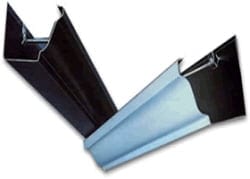 Seamless gutters are rain gutters that are cut from a preformed roll of composite metal. A rain gutter is a narrow trough that is attached to the outer edge of the roof to collect water and redirect it away from the building. Rain gutters are also called eaves troughs or eaves channel guttering.
Seamless gutters are rain gutters that are cut from a preformed roll of composite metal. A rain gutter is a narrow trough that is attached to the outer edge of the roof to collect water and redirect it away from the building. Rain gutters are also called eaves troughs or eaves channel guttering.
If you are thinking about installing seamless gutters, make a list of your requirements. Determine the color of the gutters and the total length required. The gutters can be the same color as the roof or can coordinate with the other trim on the building.
When selecting a seamless gutter contractor, ask for a written quotation. The quotation should provide detailed pricing for the materials and installation labor. Obtain quotes from at least three different Installers to ensure you get the best price. Contact us for your free quote!
Ask for and check at least three references from prior customers before selecting a seamless gutter contractor. Ask the references if the work was completed on time, and their satisfaction with the quality of work. Take the time to visit the references and inspect the quality of the installation before selecting a contractor.
When the seamless gutter contractor arrives, they will have a Gutter machine inside a truck which contains a roll of metal in the selected color. The seamless gutter is formed on site from this roll. The gutter is then installed onto your fascia.
At each corner, the seamless gutter is cut just enough to allow the material to create a perpendicular corner. These cuts are then sealed during the installation process. The seal can be created on the inside of the gutter to provide a visually appealing appearance.
The installation staff work their way around the perimeter of the roof, attaching the seamless gutter as they go. Downspouts are usually installed at the end of the process. The downspouts are used to allow the water collected in the rain gutter to run off the roof to another location. For more information please contact us.
Special Coupons – Unlisted secret page:)
[coupon couponid=”loop” category=”” couponorderby=”date” coupon_align=”cctor_aligncenter” name=”Coupon Loop”]
Everything Gutter Testimonial
Customer sent us over a video after completing a new gutter and gutter guard installation to says thanks!!!
Everything Gutter Testimonial
Customer sent us over a video after completing a new gutter and gutter guard installation to says thanks!!!
Do You Really Need Gutter Guards?
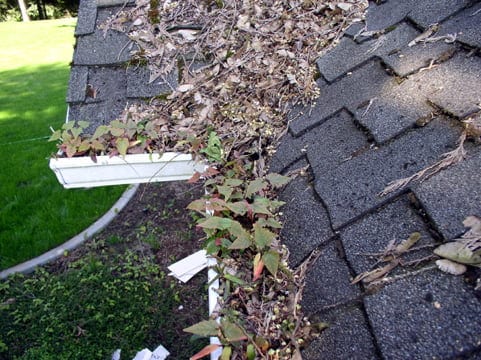 Well there is really no way to give a simple yes or no answer to that question. But one thing is certain, and that is that rain gutters need to be unobstructed so that water can flow freely to the downspouts and be carried away from the house. If that doesn’t happen you are sure to run into serious problems in and around the house. But, if for some reason your gutters are not subjected to falling leaves and other debris such as branches, twigs, etc., then you may not need any type of protection, but they should be checked occasionally. If your home does have trees near it and leaves blow onto your roof and into your gutters, and you are willing and able to clean the gutters out frequently then you may not need a gutter guard. And of course you could always pay someone to clean your gutters frequently once again eliminating the need for a guard. But let’s be realistic about the situation. It is very unlikely that your gutters will be cleaned frequently enough to assure that problems do not occur. And paying for cleanings frequently enough can run into some serious expense. And even when the situation is being handled frequently, there are things that can be overlooked. For example, downspouts can be clogged with leaves and that problem goes unnoticed because the clog is out of sight (and out of mind). While it may sound as if I am stating that there is a need for gutter guards, I am not. I am simply stating that gutters need to be free of leaves and other debris in order to function properly. Gutter guards may be the easiest and most economical way to make that happen.
Well there is really no way to give a simple yes or no answer to that question. But one thing is certain, and that is that rain gutters need to be unobstructed so that water can flow freely to the downspouts and be carried away from the house. If that doesn’t happen you are sure to run into serious problems in and around the house. But, if for some reason your gutters are not subjected to falling leaves and other debris such as branches, twigs, etc., then you may not need any type of protection, but they should be checked occasionally. If your home does have trees near it and leaves blow onto your roof and into your gutters, and you are willing and able to clean the gutters out frequently then you may not need a gutter guard. And of course you could always pay someone to clean your gutters frequently once again eliminating the need for a guard. But let’s be realistic about the situation. It is very unlikely that your gutters will be cleaned frequently enough to assure that problems do not occur. And paying for cleanings frequently enough can run into some serious expense. And even when the situation is being handled frequently, there are things that can be overlooked. For example, downspouts can be clogged with leaves and that problem goes unnoticed because the clog is out of sight (and out of mind). While it may sound as if I am stating that there is a need for gutter guards, I am not. I am simply stating that gutters need to be free of leaves and other debris in order to function properly. Gutter guards may be the easiest and most economical way to make that happen.
So, if you decide on using a gutter guard there are a few things to consider. There are many types of guards on the market, ranging from extremely expensive, to very cheap. The thing to remember is not to judge the performance based on the price. Some of the most expensive guards can actually cause more problems than they solve. So what should you look for? It certainly isn’t rocket science. Gutter guards need to be made of a sturdy material. The very cheapest ones can collapse into the gutter and become a catch point for debris to form a dam and block the flow of water. Avoid guards with gaps in the front because leaves can blow in the gaps, clog the gutters, and then cannot be reached in order to clean them out. Many of the gutter hoods are effective in light rain, but can overflow during heavy downpours, and can also have the dreaded gap in front. And avoid anything that needs to be attached to the roof as this can affect your roofer’s warranty should a leak occur. So a sturdy guard that attaches only to the gutter, with perforations to allow only water into the gutter seems to be the most logical choice. Often times this is the most economical (not cheapest) way to go. If the installation is being done by a professional (highly recommended) be sure to get a written warranty and performance guarantee. Avoid contractors who do not specialize in gutters or those that make use of sub contractors. Doing this job right will allow you to have many years of trouble free performance.




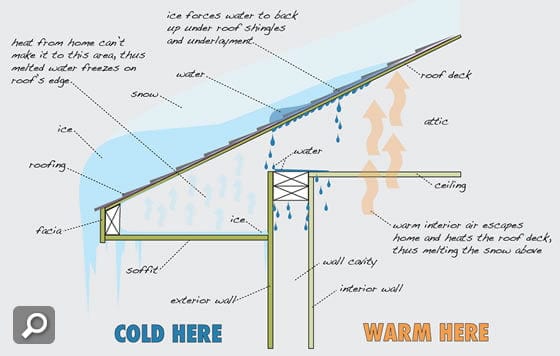
You must be logged in to post a comment.